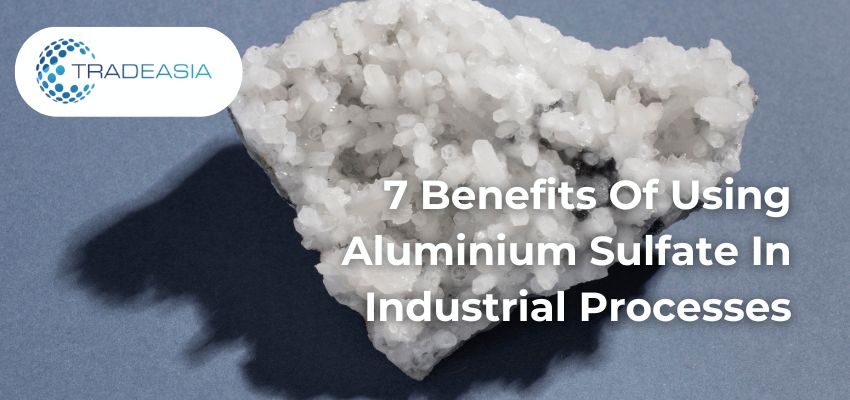Water Treatment Chemicals
7 Benefits Of Using Aluminium Sulfate In Industrial Processes
13 February 2024
Table of Content
- How is Aluminium Sulfate made?
- 7 Enormous Functions of Aluminium Sulfate in Industries
Water Treatment Chemicals
13 February 2024
It was during ancient Egyptian times when the civilization found out the use of Aluminium Sulfate as an aid in the dyeing process. This chemical compound with the formula of Al2(SO4)3 is available in dry crystal form, a powdery substance that goes slimy once it gets contact with water.
The compound is considered as salt with high solubility in water. However, nowadays Aluminium Sulfate also known as Alum is much more widely used than just in the dyeing industry. From being coagulant in water treatment to ingredient in some household products, what are the other uses of aluminium Sulfate in industries? Check here to find out.
Before being transported to the consumers, aluminium Sulfate goes through some production processes first. Essentially, the compound is obtained through a reaction of sulfuric acid and aluminium hydroxide. The whole process starts with grinding bauxite as a source of aluminium hydroxide. Based on the most common overall equation of the manufacturing process, the reaction also exudes water.
During the process, aluminium hydroxide is blended together with sulfuric acid at a desired temperature and pressure to acquire aluminium sulfate. The product is more commonly sold in liquid form. Liquid aluminium sulfate is prepared by diluting it in solution, preferably water. On the other hand, the compound can also be in dry powder by evaporating it to be crystallized. Once the production stage is done, then can be transported using container or bulk by rail, barge, ship, and truck.

1. A mordant in dyeing industry
The use of aluminium sulfate as a mordant for dyeing has been known since the 2nd millennium BC. But, what is mordant exactly? So, mordant or dye fixative is a material that is used to open up the fibers pores in order to ease the colorant penetrate deeply thus it will be attached to the fibers. Mordant is usually applied on the fibers before or after the dye is being set. Once it converges with the dye, they create a complex bond thus the dye will be settled on the fibers.
The process of spreading mordant on fibers is called mordanting. It is the most important part of preparing fibers to receive colors. The aim of going through mordanting is to ensure the colors stay durable and long-lasting on the fibers. Through centuries, people have had many ways to use mordants. It can be used either before drying the dyed fibers or after. Broadly, mordants are sorted into three groups which are metal salts or metallic mordants, tannins and tannic acid, and oils or oil mordants.
Aluminium sulfate belongs to the first group. However, it is mostly used as one of the easiest methods to mordanting only animal-based (organic) fibers such as wool along with cream of tartar. Thus, applying it to modern synthetic dye will not be feasible. To estimate the recommended amount of aluminium sulfate, it can be calculated as 12% of Weight of Fibers (WOFs). The greater the percentage, the deeper shade of color it will get. For industrial purposes nowadays, It is also used as an aid to dye on papers.
2. A coagulant in water treatment industry
Evolving through thousands of years, It is no longer used only as a mordant. Moreover, the compound’s biggest use on an industrial scale is to be a coagulating agent in water treatment plants. Clean and safe water is a fundamental demand to construct modern infrastructure, therefore aluminium sulfate is essential for the role.
When blended with water, aluminium sulfate is getting along with microscopic impurities so that it will clod together into larger and bigger particles. As it gets greater in size, the particles will sink to the bottom of the container therefore it can be sieved and what is left is clean and safe water to be consumed.
3. Algae control in the agriculture industry
It is not uncommon to find devastating phenomena in lakes across the United States during autumn when it is covered by what seems like a strong green colorant. That is what is called an algae bloom. While it attracts people aesthetically, the events can turn to be toxic and damaging to the ecosystem in the lake water.
As it regularly happens, scientists are battling it with chemical weapons. The ones that we know as aluminium Sulfate. By injecting it into lakes in appropriate amounts, it can neutralize the pollutants, which is in this case phosphorus for the blooms’ fuel, being reduced greatly.
Based on the research, using aluminium Sulfate as an algae control agent can actually work due to the affinity of the compound for phosphorus. As it is mixed with water, alum forms a cotton candy substance. Then, the flocculation will grab it when it settles to the bottom of the lake, returning the clear and colorless water to life once more.
4. A sizing agent in paper manufacturing

Another use of aluminium sulfate in paper manufacturing besides the aid for dyeing, is to be a sizing agent. In this process, aluminium sulfate needs to be mixed with rosin soap in order to alter the absorbency of the paper. Moreover, it affects the ink-absorbing properties of the paper. The combination of aluminium sulfate in the making of paper results in acidic paper which can break down faster than acid-free paper.
5. Food industry
As a multipurpose compound, It is also commonly used in the food industry as a thickener and emulsifier. Specifically, aluminium Sulfate is known to get involved in clarifying and remineralize water for carbonated drinks, controlling the pH of alcoholic based drinks such as wine and liquor, purifying the sugar beet juices, act as a leavening agent in cake mix and many more. However, the compound is only recognized as safe when in use according to the good manufacturing practice.
6. Medical purposes
Aluminium sulfate’s function as a coagulating agent is not only used for treating water but also for medical purposes, specifically for treating minor cuts and abrasions. Known for its support for high absorbency properties, aluminum Sulfate is often used to adsorb and precipitate protein antigens in solution, ensuing precipitation to improve vaccine immunogenicity. Other uses include being utilized in the preparation of aluminium acetate-based ear drops and deodorant due to its antibacterial features.
7. Additive in cement industry
One more application of this multifunction compound is being a typical additive for cement production in the construction industry. The aim is to increase the viscosity of the concrete mass, preventing the deposition of sediment and moreover the dripping from the wall. It is either in powder or liquid form of aluminium Sulfate to be mixed with the cement. Scientific research showed that the addition of the compound will shorten the setting time of cement, improve the drying shrinkage, and thus supporting the early strength of the construction.
It is safe to say that aluminium Sulfate is among the multifunctional chemical compounds ever used in human civilization. Being obtained from the reaction of aluminium hydroxide with sulfuric acid, the compound has been recognized since 2nd millennium BC as a mordant in organic fiber. Through thousands of years, aluminium Sulfate has spread its functions as a coagulating agent both in the water treatment industry and for medical purposes, algae control for vanishing water pollutant, as well as an additive to cement in the construction industry. Just wait for several years ahead to add another role to the list!
We're committed to your privacy. Tradeasia uses the information you provide to us to contact you about our relevant content, products, and services. For more information, check out our privacy policy.
Leave a Comment